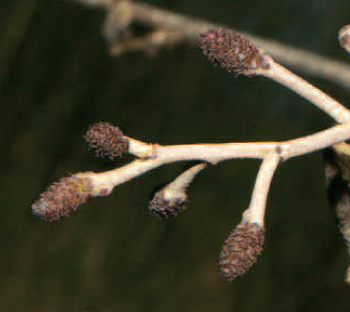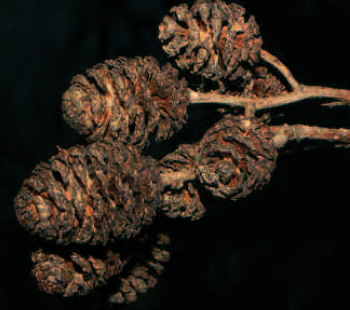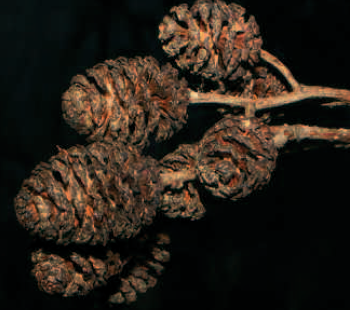
It is increasingly being recognized within the framework of close-to-nature fishkeeping that the maintenance and breeding of fishes, shrimps and other crustaceans, gastropods, bivalves, and aquatic plants goes better and is more satisfying the more closely it imitates the example of nature. Anyone who wants to take this route will very soon encounter the largest of all the terrestrial plants, the trees, along the way. Their branches and roots provide hiding-places, their leaves form the basis of the food chain in almost all the waters that are home to ornamental fishes in the wild, and provide a lot of small creatures with their daily bread. But only a few aquarists are aware of their medicinal properties – pity!
Siehst, Vater, du den Erlkönig nicht?*
“Der Erlkönig”, written in 1782, is probably the best-known poem by Johann Wolfgang von Goethe, and tells how the Erlkönig (= Alder King) tries to carry off a small boy being borne on horseback in his father’s arms, while the latter is unaware of the evil presence. Since time immemorial the Common Alder (Alnus glutinosa) has had a sinister aspect in folklore. The Alder King may be a figment of the imagination, but the Alder’s habit of growing in wet, swampy surroundings has historically given it a less than favorable reputation among humans. But not among the pioneers of the aquarium hobby. Anyone who keeps snakes, toads, and slippery fishes at home won’t be too worried about the Alder’s reputation and will put aside ancient prejudices against the environment it inhabits. And thus it was that our forefathers in the hobby very quickly discovered that the fruits of the Alder, the so-called Alder cones, were a first-class natural healing medium.
* Father, don´t you see the Alder King?
The Alder from a botanic viewpoint
The genus Alnus – alders – is represented by three species in central Europe. Worldwide there are between 17 and 50 species, depending on the opinion of the scientist in question. The truth probably lies somewhere in between. All alders are trees or shrubs. But only the Common Alder is perfectly adapted to wet locations, so there is no risk at all of any confusion. The Common Alder is a member of the birch family (Betulaceae), and hence is related to the birches (Betula) and the hazelnuts (Corylus). Like them it has male and female flowers, both on the same tree. The male flowers, which produce the pollen, are called catkins. The female flowers are very inconspicuous and sit in clumps at the ends of small twigs. Pollination is effected by the wind.
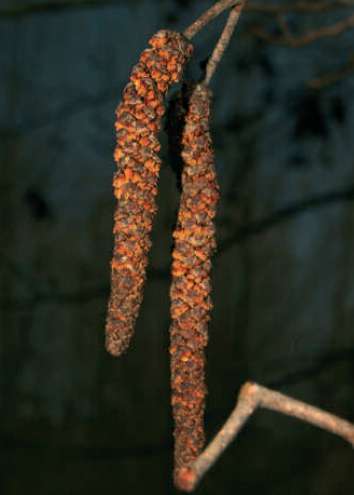
Male Common Alder flower (catkin).
Survival specialists
Like all animals and plants on this planet, the Common Alder requires oxygen for respiration. Trees that stand in water for any length of time suffocate and die. But not Common Alders. Why? The Common Alder is the only species of European tree with the ability to take up oxygen from the air via its trunk and transport it to the roots, where it can be breathed. In addition, as an adaptation to nutrient-poor marshy soils, the Alder lives in symbiosis with bacteria that can bind nitrogen direct from the air. Nitrogen is one of the most important of all plant nutrients. And finally, the Common Alder has evolved a host of decay-limiting substances that prevent the plant from rotting in the waterlogged environment in which it lives. It is mainly these fungicidal and bactericidal substances that make the Alder so valuable to aquarists.
The effective ingredients
Unfortunately there has been no scientific research into the precise substances contained in Alder cones, or at least none is known to us. But because the bark and leaves of the Common Alder are used in human medicine, their contents are well known. As with all natural products the concentration of the individual substances varies depending on the location and the time of collection, but as a rough rule of thumb it can be stated that some 10-20% of the contents are tannic acids, while additional main active ingredients are phenylpropane (flavonolglycoside (hyperoside)), cinnamic acids, stilbene derivatives, steroids, and triterpenic acids (taraxerol (alnulin) and taroxeron (protaenulin)), and ancillary substances are anthraquinone (emodin), sugars, uric acids, and waxes (all data after LAGONI, 2003).
Usage
In human medicine Alder-bark teas are used as a gargle to treat inflammation of the mouth and throat, tooth and throat pain, and bleeding gums; Alder bark is used to make a lotion or poultice, and the leaves to treat all sorts of skin conditions, eczema, infected wounds, burns, and hemorrhoids. Strange to say Alder cones aren’t used in classic medicine, though they are used in folk medicine, to produce an aphrodisiac.
Their use in the aquarium is simplicity itself and has been tested thousands of times: they are added to the aquarium at the rate of one Alder cone per 10-20 liters of water. And that’s it. You can also use a lower dosage – with natural medications the rule “more helps more” generally DOESN’T apply. On the contrary, traces of medication are often a lot more effective. It is virtually impossible to overdose, although the water will become increasingly less transparent until it eventually takes on the color of strong coffee. Even this water is generally harmless to the livestock, though the plants will suffer considerably due to the lack of light caused by the brown coloration.
- Female Common Alder flowers.
- Alder cones
Do Alder cones make the water acid?
Essentially the answer is yes! The pH will generally be affected by the tannic acids, as can very easily be checked. Distilled water has a pH of 7 and no buffering capacity, and so can’t “capture” and neutralize any acids. If eight Alder cones are placed in a glass containing 100 ml of distilled water (which is a lot more than the dose that would be used in the aquarium), this lowers the pH from 7 to slightly over pH 4.
Statements to the contrary may perhaps relate to the collection time. Alder cones are best collected in winter, when they ave shed their seeds. Alder seeds are undesirable in the aquarium as they will merely pollute the water unnecessarily. Because the scales of the cones open only in dry weather to release the seeds, it may happen that a certain amount of rain may already have washed over the cones before the time comes to harvest them. It may be that cones harvested before they are ripe and then dried have a different effect on the water chemistry and in particular on the pH, and the same may apply to those harvested in the spring or summer, but we haven’t experimented to check. The Alder cones sold in the trade, e.g. at Aquariana, originate from winter harvesting and will lower the pH in soft water.
When to use Alder cones, and what for?
It can be said of Alder cones that they never do any harm and are almost always beneficial. Hence it is essentially advisable to have Alder cones in the aquarium (at a low dose because of the plants). Dose at the rate of one Alder cone per 10-20 liters of new water after every partial water change. Older, expended cones look unattractive and hence should be removed, though that is a matter of individual taste. They won’t do any harm. The same applies here as with all natural medications: in the case of acute illness they will support the healing process, but WON’T replace conventional medicine! Their most important effect is that the animals and plants in the aquarium will be healthier through the use of natural products such as Alder cones, and hence hardly ever get sick!
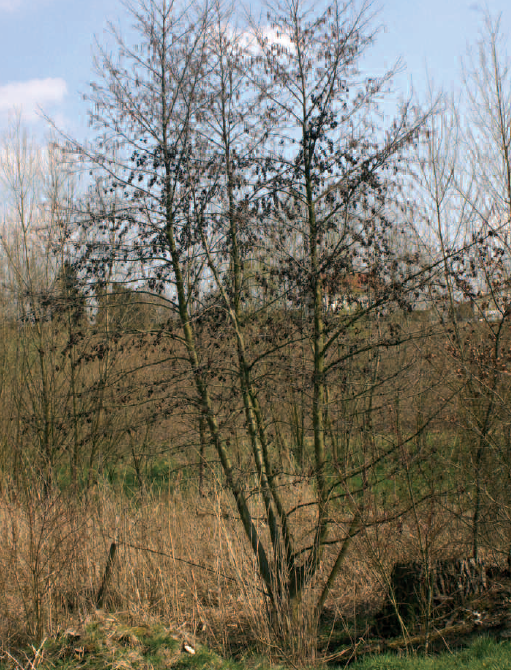
Common alders are short-lived and live for only 100-120 years. Even young trees fruit abundantly.
Anzeige






